
In ancient Egypt and Babylon, sphinxes where known as guardians of sacred places. Could it be that the Great Sphinx of Giza in Egypt is also guarding something of great importance? According to ancient testimonies and several psychic intuitives there would be tunnels and hidden rooms beneath the Great Sphinx and the pyramids of Giza.
Secret
Chambers
The French author Jean-Baptiste Pitois
(under his pen name Paul Christian) wrote in his book: "Historie de la
Magie, du monde Surnaturel et de la fatalité à travers les Temps et les
Peuples" (1870)
(translated in English as: "The History and Practice of Magic"), that
the Sphinx
served as the entrance to the sacred subterranean chambers in which the
trails of the initiate were undergone. It would have been formerly
closed by a
bronze gate between the paws of the Sphinx, with a secret spring
mechanism which could be only operated by the magi. (Magi were
Zoroastrian
priests. Singular: "magus".) In the belly of the
Sphinx would have been cut out galleries that would lead to the
subterranean part of the Great Pyramid. These galleries were so
artfully criss-crossed along their course to the pyramid that in
setting forth into the passage without a guide through this network,
one ceaselessly and inevitably returned to the starting point.
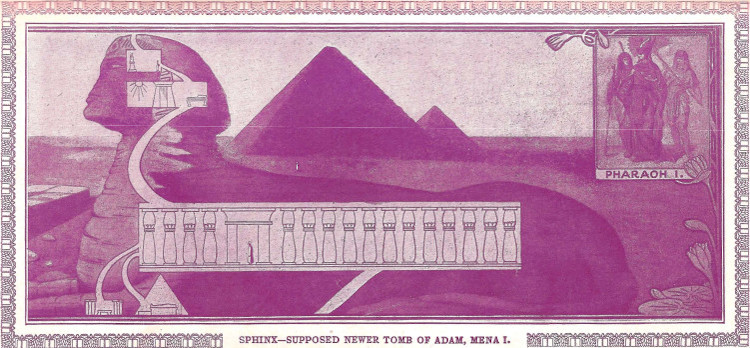
From the book: "Scenario of the
Photo-Drama of Creation"
From 1912 to 1914, the Watch Tower Bible
and Tract Society of Pennsylvania (Jehovah’s Witnesses) produced an 8
hour multi-media presentation of 4 parts called: "The Photo-Drama of
Creation". It was the first major screenplay to incorporate
synchronized
sound, moving film, and color slides. Its director, Charles Taze
Russell, also published an accompanying book: "Scenario of the
Photo-Drama of Creation". Quite unexpectedly and seemingly out of
place, on page 21 of the book is a remarkable drawing of
the Great Sphinx that shows an illustrated inside view of the great
structure. (See the
image above.) It depicts an entrance at the top of the head, a long
hall with sturdy supporting pillars, a small room located within or
between the
paws, and a triangular chamber that appears to be a small pyramid with
a sarcophagus inside. Along with the depiction at the top-right (with
the text: "Pharao I"), it is clear that they either thought or believed
that the first Pharao had his tomb here within the Sphinx. Where does
this come from? Was it perhaps based on knowledge of the keepers of the
original ancient
Egyptian traditions? Local Egyptians long believed that the monument
contained the tomb of an ancient Egyptian Pharao. (See: The
Dream Stele.)
Because of an article in "The Egyptian Gazette" from 1913, some internet sources claimed that this image was probably based on information of American archaeologist George Andrew Reisner (1867-1942). According to the report, Reisner would have found a temple dedicated to the sun and other hidden chambers inside the structure of the Sphinx. Reisner himself actually never mentioned such a discovery in his works, and if he indeed discovered hidden chambers within the Sphinx it surely couldn't have gone unnoticed, as the chambers would be probably full of sand and it would have taken a very long to clean it up. Anyway, several weeks later the Egyptian Gazette asserted that the whole story of the discoveries was fabricated by American journalists. So, it proved to be nothing more than a journalistic hoax. (Source: "The Advertiser", on Trove.)
The Hole in the Head
At the time of writing it is relatively unknown that the Sphinx originally had a deep hole within the top of the head. It was first noted in 1733 by the British merchant Charles Thompson during his travels. He wrote that people have reported a round hole where a full-grown person could descent into. French emperor Napoleon Bonaparte's expedition in Egypt (from 1798 to 1801) also made note of the hole and would have been reportedly ten feet deep and was full of sand. The image below is a 19th century photo taken from a hot air balloon, when the paws of the Sphinx were still not fully uncovered.
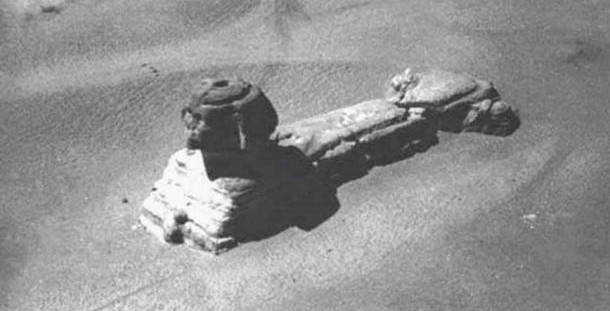
A rare 19th century photo taken from a hot
air balloon
In 1923 the hole was measured by Department of Antiquities director Lacau and engineer Émile Baraize. The hole was approximately 5 feet square and nearly 6 feet deep. From 1925 to 1936, Baraize was involved in restoration of the Sphinx and completely clearing away the remaining sand from it. He also directed excavations around, but also inside the Sphinx, in search of the hidden rooms where many Egyptologists from the 19th century believed in. These excavations were hurried and had to be carried out with minimal equipment, but he did partially succeed in his objectives, for tunnel had been discovered, starting at the rump. (Source: Wikipedia.)
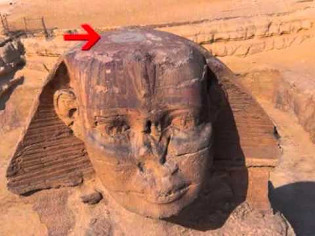 As part of the restorations, the hole on
top of the head had been
sealed off with a metal plate with a openable round iron hatch in the
middle. (Seen in the images below.) According to the account of
Egyptologist Selim
Hassan ("The Sphinx: Its History in the Light of Recent Excavations"
(1949)), the reasons for restoring the Sphinx was to add more support
and protect it from rain that had been water pouring into the cracks
and holes, which before the stone could split. The hole on top of the
head probably was also covered
for this very reason.
As part of the restorations, the hole on
top of the head had been
sealed off with a metal plate with a openable round iron hatch in the
middle. (Seen in the images below.) According to the account of
Egyptologist Selim
Hassan ("The Sphinx: Its History in the Light of Recent Excavations"
(1949)), the reasons for restoring the Sphinx was to add more support
and protect it from rain that had been water pouring into the cracks
and holes, which before the stone could split. The hole on top of the
head probably was also covered
for this very reason.
It had been theorized by Egyptologists that the purpose of the hole could have been for affixing a headdress on top of the Sphinx, and may later have been further deepened by grave robbers in search of hidden chambers. But the hole would be too small for this, and heads and headdresses on other colossal statues where always carved as a whole. Furthermore, the Sphinx is clearly depicted on the "Dream Stele of Thutmose IV" without a headdress and there are no indications that the Great Sphinx ever had one.
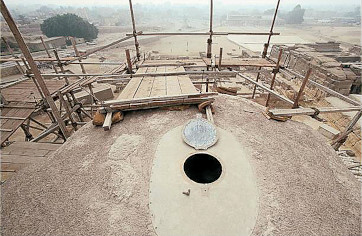
Opened hatch at the top of the Sphinx
(Photo by Eric Brissaud/Gamma-Rapho, 1991)
The
Dream Stele
The image below is from the upper part of the so-called "Dream Stele of Thutmose IV". This stone tablet tells about the dream of Thutmose IV in which he was approached by the spirit of King Harmakhis who promised him the throne if he would clear the buried Sphinx from the sand. After he cleared the sand, he indeed became pharao. He wrote his story down in stone and erected the tablet between the front paws of the Great Sphinx, where it is still standing today.
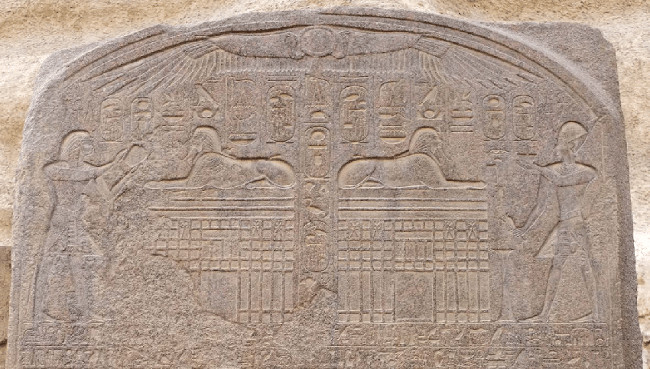
The Dream Stele of Thutmose IV
(Photo by R.M.S. and his wife Catherine Ulissey, 2015)
The scene shows Thutmose IV on the far left side of the tablet. The figure on the right side probably is King Harmakhis, as he wears an ancient Egyptian crown. As the Sphinx is shown on a high pedestal, with possibly an entrance at the base, it has contributed to the idea that a temple or passageway may exist beneath the Sphinx. According to the account of Egyptologist Selim Hassan, there was the intention to find out if this could be true. However, clearing the Sphinx from the sand and other works proved to be very time consuming. Unfortunately they ran out of time and had to stop their investigation after the body was cleared.
The winged sun disk at the top of the stele represents the
"divinity"; the divine world. The
blocks, squares and "v-shaped" depictions that are visible on the
tablet, are the
kind of royal decorations usually seen at façades of ancient Egyptian
palaces and on tombs, and therefore the pedestal signifies something of
great importance. From Hassan's account, the Roman Pliny (23
AD) took note of the testimony of an Alexandrian historian and came
to the conviction that it would contain the tomb of King Harmakhis.
Local
habitants of the district would have believed this too.
If the depiction would be true to scale, it means that the pedestal would be more than 40 meters high, because at least two other Sphinxes of the same size would fit in, and the Sphinx has a height of 20 meters. Did Thutmose IV saw the Sphinx on a huge pedestal, the size of a large building, in his dream? Although there is nothing written about a tomb or hidden chambers, part of the tablet had been severely damaged and therefore the bottom text had been lost. As of today, approximately half of the text is now missing.
Psychic Insights
Several psychic intuitives spoke about a mythical library of ancient knowledge both within as deep beneath the Great Sphinx of Giza. The American clairvoyant Edgar Cayce (1877-1945) mentioned in his readings that somewhere deep below within the bedrock between the Great Sphinx and the "river" (the Nile), there would be an ancient repository that he referred to as the "Hall of Records". Here would be found - amongst other things - a historic record from the times of Atlantis, information about the customs and practices, scientific and medical knowledge, and music instruments. The opening to the tunnel that would lead to this place was said to be found in the right shoulder of the Sphinx. He predicted that these hidden records were expected to be discovered in 1996 to 1998, but this apparently didn't happen.
Edgar Cayce also said that there would be more then one "Hall of Records", which would be hidden in other locations of the Earth. One below miles of sea slime in a temple of the sunken island Poseidia, one in the Yucatán Peninsula in Mexico, and one in Tibet. Trance clairvoyant Dr. Douglas James Cottrell also mentioned another undiscovered repository of ancient knowledge below the temple complex of Angkor Wat in Cambodia. (See the video: "Rev. Douglas Cottrell PhD: Secrets of Angkor Wat", by Rammsteinregeln.)
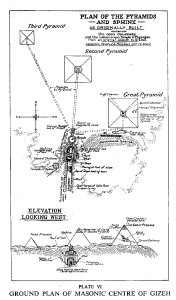
The mystic Hugh C. Randall-Stevens wrote in his book "Atlantis to the
Latter Days" (1954), about his channeled material from two beings named
Adolemy and Oneferu. Adolemy had been incarnate under the name Osiraes
in the reigns of Amenhotep III and IV, and Oneferu had been incarnate
under the name Men-Aton during the reign of Akhnaton. In the Masonic
Centre of Giza he would have been given details
concerning the nature and the building of the Great Pyramid of Giza and
the Sphinx. He allegedly would have reproduced some of their diagrams
in his book which are shown here above right (larger
image) and below. (Source: "Atlantis to the Latter Days" (3rd
edition, 1966).)
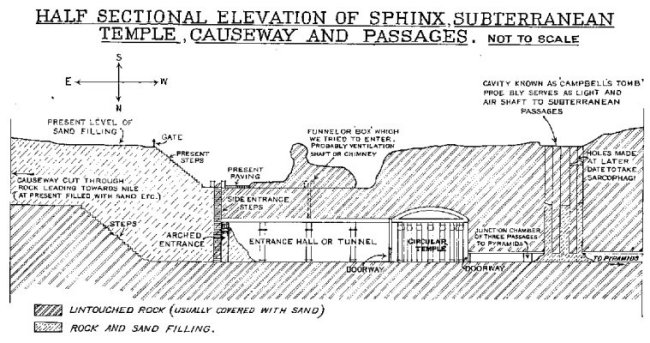
The Hall of Records were also the subject of as much as 41 readings by deep trance medium Paul Solomon. During his reading given at the pyramid of Giza on January 23, 1981, he also described what would be found within the ancient Egyptian Hall of Records and also contains a warning to humanity to switch to alternative energy sources before it could be too late. Quoted from the website www.wisdomofsolomon.com:
"Many have thought and said that (the Hall of Records) were sealed until the evolution of consciousness ... arrives at that point of attunement deserving of the information contained there. But it would be more accurate to say these records were stored against a time when they were needed. . . .
You are ... on the brink of destroying the balance of the natural energies in and about this planet. And, in deed, affecting the balance of the entire system, the solar system, the universe itself. Then, the destruction of weather patterns, the imbalance of nature, the burning of fuels, has produced a difference in your atmosphere, both in temperature and the filtering of the rays of energy to your planet. All of these become threats to the existence of your race.
Within this Hall of Records, you will find formulas, descriptions of methods, very simple methods in truth, for harnessing, for using the power of nature itself. It is not necessary to take the fossil remains from the Earth and burn it to produce energy on this planet.
The planet itself is designed in such a way, that holding its balance, its relationship through magnetic forces, through the forces of gravity and movement in relation to other bodies in the system, (it) produces enormous free energy. And it is simple, when working in harmony with nature, to use the energy nature produces and provides both through the movements of water on the planet and the influx of energy from the sun. Not just the energy of heat, not just solar energy, but rather magnetic and gravitational forces and these may be harnessed in a number of ways.
That (is) most available through the use of crystals. It is no secret that crystals easily can accept the rays of the sun, focus and magnify them to produce a greater source of energy than it receives. ... As you see these devices and formulas of a past time, you’ll see them appearing to you as somewhat primitive and yet, in the application of them, far superior to that you now have.
The formulas concern the use of energy. The harnessing of energy in harmony with the planet in natural ways not needing the use of machinery as you know it, but focusing of the available energy through crystalline forms and harmonics. The use of sound and light primarily, and energies you do not have words for, but relate closely to that you call the ethers, electricity, magnetic energy and gravitational energy. These are there. And the use of the mind as a magnificent instrument of understanding of the Laws of the Universe, these formulas are there as well.
There are fragments of a culture, records of its source and beginnings. Records of the lives of these and even the preservation of such things as their garments, their instruments, even food is still stored there, both edible and palatable. Seeds, seeds of such plants as you do not know in this time and will be useful in that period of recovery and the cleansing of the atmosphere."
(Note: ".
. ." and "( )" implicate changes to the text to make
it easier to read without changing the context.)
And from Paul Solomon's Source Reading 9217 (3/27/88):
"For those who attempt to dig to enter into the Hall of Records of the Great Pyramid will find themselves somewhat disappointed. But those who discover the manner of passing through the stone, will pass into the chamber and find there instruments which would amaze those who consider themselves superior in technology in this time."
Trance medium Daan Akkerman receives messages on from the masters of
the White Brotherhood. In his book: "Lanto 1: Atlantis and ufo's"
(2003), they
gave information on topics such as: Atlantis, Egypt and
extraterrestrial life. According to the information from the chapter
about Egypt; inside a subterranean space between the front legs of the
sphinx is a gateway to a deeper part, where far below the ground nearby
the three great pyramids will be discovered
a space that is full of information from the ages of Atlantis and
Lemuria. Here one shall find knowledge about transformation of matter
and levitation; the nullifying of gravity. From pages 202 and 203 of
the book
(loosely
translated from Dutch):
"The library, which is present both under the pyramid as well the sphinx, is so enormous that it covers the whole. The whole lies both under the pyramid and under the sphinx, with a connecting system to other pyramids. This lays very deep. It is filled with huge crystals, with many pictures, with objects that were used in Atlantis, with spaceships that visited the Earth during that time. It is a city under the Earth, enormously big. You will understand that all this information will emerge within the years you are living in...
When today's mankind
has balance between thinking and feeling and [therefore] pure intuition
can be developed, then the time has come that the libraries of
Atlantis can be opened."
Recent Developments
It had been said by many mainstream Egyptologists that there is no evidence to indicate the Egyptian Hall of Records really exists, and that there are no chambers under the Sphinx. However, Dr. Zahi Hawass - now the previous Director General of the Giza Plateau - did affirm the presence of three tunnels at the Great Sphinx. The first tunnel is situated above the back of the monument and was discovered in 1937 by the French engineer Bering who was searching for treasures inside the body of the Sphinx. The second tunnel was found at the north side by the French Egyptologist Gupino. It was believed that the tunnel was full of treasures and other valuables. The third tunnel is located behind the "Dream Stele" and was found by the Italian adventurer Kavliain during the early 19th century, when he was digging under the chest of the Sphinx.
Robert Temple's book: "The Sphinx Mystery" (2009) presents a summary of many printed accounts of earlier observations from past centuries from where it is clearly evident that there are not only tunnels but also cavities below the Sphinx that had been examined and documented before. The general perception is however, that they would just be natural formations, but at least for one certain tunnel this seems unlikely because of a sharp 90 degree turn.



